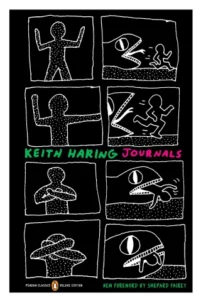Keith Haring on Our Resistance to Change, the Dangers of Certainty, and the Root of Creativity
INSPIRATIONAL, 19 Sep 2022
Maria Popova | The Marginalian – TRANSCEND Media Service
“It is almost banal to say so yet it needs to be stressed continually: all is creation, all is change, all is flux, all is metamorphosis,” Henry Miller wrote as he contemplated humanity’s future. And yet it does need to be stressed continually, because coursing through us is the fundamental paradox of our humanity: our longing for permanence amid a universe governed by entropy — the great source of our existential restlessness and our creative fury, to which all of our sorrow and all of our art can be traced.
The oracular Octavia Butler captured this in her reckoning with the meaning of God: “the only lasting truth is Change.” The rest of nature is constantly attesting to this inconstancy. And yet with every fiber of our being, we resist its fundamental reality — even though our very fibers, each and every cell composing us, have been replaced since we first came into being. As life lives itself through us, our bodies change; the physical places and social spheres we inhabit change; if we are alive enough and courageous enough, our opinions and ideas about life change. And yet we cling to the comforting illusion that we remain, in some unmappable region of being, fundamentally ourselves — our immutable selves.
Keith Haring (May 4, 1958–February 16, 1990) was only twenty and already colliding with his own impermanence when he turned his soulful intellect to these perennial paradoxes in Keith Haring Journals (public library) — the posthumous gem of a book that gave us his largehearted wisdom on creativity, empathy, and what makes us who we are.
Two millennia after the ship of Theseus and a generation before neuroscience began illuminating the dazzling realities of different minds, Haring marvels at our tactics for bridling the basic effervescence of being:
The physical reality of the world as we know it is motion. Motion itself = movement. Change. If there is any repetition it is not identical repetition because (at least) time has passed and therefore there is an element of change.
No two human beings ever experience two sensations, experiences, feelings, or thoughts identically. Everything changes, everything is always different. All of these variables merging, interacting, destroying each other, building new forms, ideas, “realities,” mean that the human experience is one of constant change and, as we label it, “growth” [and yet] most living human beings build their lives around the belief that these differences, changes, don’t exist. They choose to ignore these things and attempt to program or control their own existence. They make schedules, long-term commitments, set up a system of time and become controlled by their system of controls.

A century and a half after Emerson lamented that “people wish to be settled [but] only as far as they are unsettled is there any hope for them,” Haring considers the underlying unease that leads us to these coping mechanisms, these artificial hedges against this most natural manifestation of nature:
People don’t want to know that they change.
Unless they feel it is an improvement, and then they are all for “change,” and will go to great lengths to “make changes” or contrive situations or force a change that is unnatural… Some attitudes I see all around me are:
Change is acceptable as long as it is controllable.
Change can be predicted.
Changes can be contrived and/or altered and/or planned.
Part of our willful blindness to change in the grand scheme, Haring intimates, is our unease about change in the small scheme of the self — the multitudes we each contain, discontinuous and contradictory, a flickering of emotional and mental states that never still to a permanent constellation across the sweep of time. He observes:
Usually the underlying fact that change is reality, that we are constantly changing and constantly in difficult situations, different states of mind and actually different realities is
ignored
or misunderstood
or misinterpreted
or confronted.
Most simply, people know to some extent that they feel different at different times or look different to themselves different days, but few people really try to experience this or question it or really investigate its reasons or its implications.
In a sentiment evocative of Iris Murdoch’s meditation on the beautiful, maddening blind spots of our self-knowledge, he adds:
To be a victim of your own knowledge is not understanding what your knowledge is and what its result is.
To be a victim of change is to ignore its existence.
To be a victim of “living by what you think” is to ignore the possibilities of “another way to live” or the possibility of “being wrong about the way it is” or ignoring the possibility of “not knowing what you think.”
Thinking you know the answer is as dangerous as not thinking about the possibility of no answers.
Creativity, Haring suggests, is a form of candor, a kind of fidelity to reality — a way of responding to change genuinely rather than artificially:
Pure art exists only on the level of instant response to pure life.
[…]
I am interested in making art to be experienced and explored by as many individuals as possible with as many different individual ideas about the given piece with no final meaning attached. The viewer creates the reality, the meaning, the conception of the piece. I am merely a middleman trying to bring ideas together.
Complement this fragment of the wholly wondrous Keith Haring Journals with the forgotten prodigy William James Sidis on the controversial science of change and reversibility, then revisit Haring on the love of life even in the face of death.
_______________________________________
 My name is Maria Popova — a reader, a wonderer, and a lover of reality who makes sense of the world and herself through the essential inner dialogue that is the act of writing. The Marginalian (which bore the unbearable name Brain Pickings for its first 15 years) is my one-woman labor of love, exploring what it means to live a decent, inspired, substantive life of purpose and gladness. Founded in 2006 as a weekly email to seven friends, eventually brought online and now included in the Library of Congress permanent web archive, it is a record of my own becoming as a person — intellectually, creatively, spiritually, poetically — drawn from my extended marginalia on the search for meaning across literature, science, art, philosophy, and the various other tendrils of human thought and feeling. A private inquiry irradiated by the ultimate question, the great quickening of wonderment that binds us all: What is all this? (More…)
My name is Maria Popova — a reader, a wonderer, and a lover of reality who makes sense of the world and herself through the essential inner dialogue that is the act of writing. The Marginalian (which bore the unbearable name Brain Pickings for its first 15 years) is my one-woman labor of love, exploring what it means to live a decent, inspired, substantive life of purpose and gladness. Founded in 2006 as a weekly email to seven friends, eventually brought online and now included in the Library of Congress permanent web archive, it is a record of my own becoming as a person — intellectually, creatively, spiritually, poetically — drawn from my extended marginalia on the search for meaning across literature, science, art, philosophy, and the various other tendrils of human thought and feeling. A private inquiry irradiated by the ultimate question, the great quickening of wonderment that binds us all: What is all this? (More…)
Go to Original – themarginalian.org
Tags: Change, Creativity, Inspirational
DISCLAIMER: The statements, views and opinions expressed in pieces republished here are solely those of the authors and do not necessarily represent those of TMS. In accordance with title 17 U.S.C. section 107, this material is distributed without profit to those who have expressed a prior interest in receiving the included information for research and educational purposes. TMS has no affiliation whatsoever with the originator of this article nor is TMS endorsed or sponsored by the originator. “GO TO ORIGINAL” links are provided as a convenience to our readers and allow for verification of authenticity. However, as originating pages are often updated by their originating host sites, the versions posted may not match the versions our readers view when clicking the “GO TO ORIGINAL” links. This site contains copyrighted material the use of which has not always been specifically authorized by the copyright owner. We are making such material available in our efforts to advance understanding of environmental, political, human rights, economic, democracy, scientific, and social justice issues, etc. We believe this constitutes a ‘fair use’ of any such copyrighted material as provided for in section 107 of the US Copyright Law. In accordance with Title 17 U.S.C. Section 107, the material on this site is distributed without profit to those who have expressed a prior interest in receiving the included information for research and educational purposes. For more information go to: http://www.law.cornell.edu/uscode/17/107.shtml. If you wish to use copyrighted material from this site for purposes of your own that go beyond ‘fair use’, you must obtain permission from the copyright owner.
